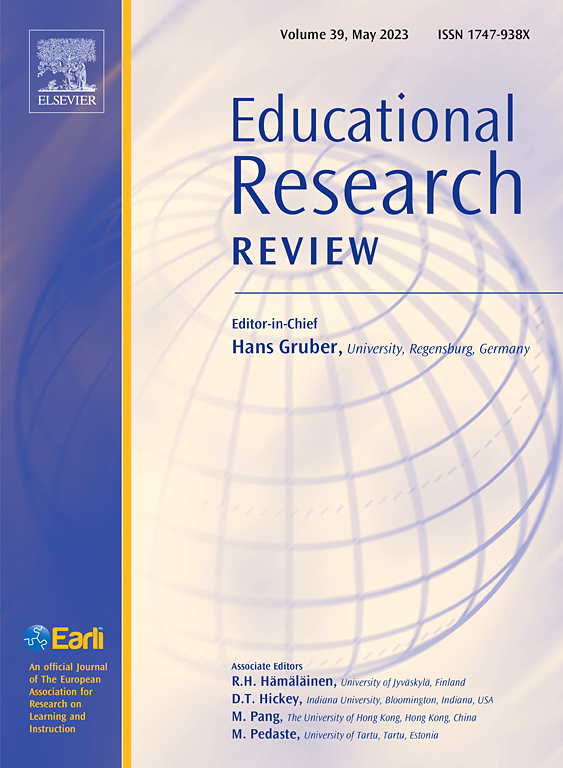Effects of content and language integrated learning at the primary school level: A multi-level meta-analysis
IF 10.6
1区 教育学
Q1 EDUCATION & EDUCATIONAL RESEARCH
引用次数: 0
Abstract
This meta-analysis synthesized the effects of content and language integrated learning (CLIL)—an approach in which non-language subjects are taught in a foreign language—on primary school students. The dataset comprised 28 samples (N = 214,103) drawn from 21 (quasi-)experimental studies that evaluated either foreign language (FL) or academic content learning. A multi-level meta-analysis revealed that CLIL was significantly more effective than non-CLIL for FL learning (d = 0.63, SE = 0.21, p = .003), with particularly strong effects observed concerning improving speaking skills (d = 1.24, SE = 0.24, p < .001) and smaller effects for improving other language domains (d = 0.48, SE = 0.18, p = .009). Additionally, publication year was significantly associated with the impact of CLIL on FL learning, with earlier studies reporting slightly stronger effect sizes than later ones, which demonstrated marginally weaker effects (β = −0.07, SE = 0.03, p = .04). In contrast, CLIL and non-CLIL approaches were comparable in terms of aiding academic content learning (d = −0.06, SE = 0.16, p = .72). Moderator analyses suggested that the observed effects of CLIL on content learning might be influenced by pre-existing differences between groups; studies with confirmed group homogeneity indicated a negative effect of CLIL on content learning (d = −0.22, SE = 0.13, p = .09), whereas studies without confirmation of group equivalence showed a positive effect (d = 0.31, SE = 0.22, p = .17).
小学阶段内容与语言整合学习的效果:一项多层次元分析
本荟萃分析综合了内容与语言整合学习(CLIL)对小学生的影响,CLIL是一种用外语教授非语言科目的方法。数据集包括28个样本(N = 214,103),来自21个(准)实验研究,评估外语(FL)或学术内容学习。一项多层级荟萃分析显示,CLIL课程对外语学习的效果显著高于非CLIL课程(d = 0.63, SE = 0.21, p = 0.003),其中口语技能的提高效果尤其显著(d = 1.24, SE = 0.24, p <;.001),其他语言领域的改善效果较小(d = 0.48, SE = 0.18, p = 0.009)。此外,出版年份与CLIL对外语学习的影响显著相关,早期研究报告的效应值略高于后期研究报告的效应值(β = - 0.07, SE = 0.03, p = 0.04)。相比之下,CLIL和非CLIL方法在辅助学术内容学习方面具有可比性(d = - 0.06, SE = 0.16, p = 0.72)。调节因子分析表明,CLIL对内容学习的影响可能受到组间既存差异的影响;证实组同质性的研究表明CLIL对内容学习有负面影响(d = - 0.22, SE = 0.13, p = 0.09),而未证实组等价性的研究显示CLIL对内容学习有积极影响(d = 0.31, SE = 0.22, p = 0.17)。
本文章由计算机程序翻译,如有差异,请以英文原文为准。
求助全文
约1分钟内获得全文
求助全文
来源期刊

Educational Research Review
EDUCATION & EDUCATIONAL RESEARCH-
CiteScore
19.40
自引率
0.90%
发文量
53
审稿时长
57 days
期刊介绍:
Educational Research Review is an international journal catering to researchers and diverse agencies keen on reviewing studies and theoretical papers in education at any level. The journal welcomes high-quality articles that address educational research problems through a review approach, encompassing thematic or methodological reviews and meta-analyses. With an inclusive scope, the journal does not limit itself to any specific age range and invites articles across various settings where learning and education take place, such as schools, corporate training, and both formal and informal educational environments.
 求助内容:
求助内容: 应助结果提醒方式:
应助结果提醒方式:


